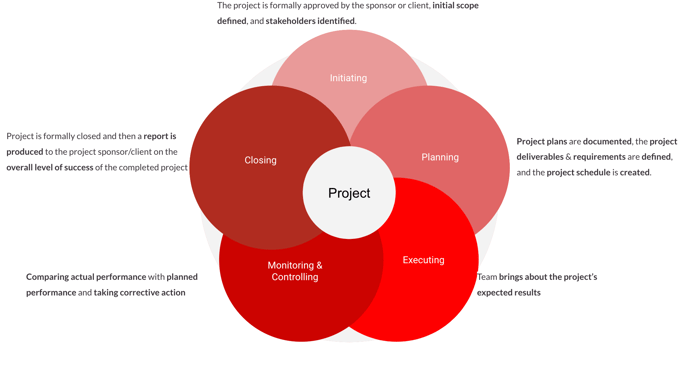Understanding the project lifecycle is key to successful project management. The project lifecycle is the path each project takes from beginning to end. While the boundaries between each step might be difficult to grasp at first, most (not all) successful projects will have a five step lifecycle. Follow this guide to learn the five steps of the project lifecycle and the actions taken in each step.

Phase 1: Initiating
The project is formally approved by the sponsor or client, the initial scope defined, and stakeholders identified. This process is performed so that projects and programs are not only approved by a sponsoring body, but also so that projects are aligned with the strategic objectives of the organization.
Draft a Statement of Work
A project manager, a delivery manager, and a team lead are assigned during Initiating phase. They’ll develop a Statement of Work together.
Statements of Work generally encompasses:
- A brief introduction to your project
- Purpose of your project
- Project scope
- Creating a work breakdown structure to identify your project tasks, milestones and deliverables.
- Creating a project schedule for your tasks, milestones and deliverables
- Defining project requirements and acceptance criteria
- Defining payment terms and conditions.
Understand the Client’s Mission, Vision, and Values
In the initiating phase, your goal as a Project Manager is to understand the client’s mission, vision, and values so you can shape your strategies for the needs of the client. There is no one-size-fits-all strategy, so it’s important to pay attention to each client's needs.
So what are the mission, vision, and values?
In short, a mission statement talks about the present moment. The mission statement defines the organization’s business, its objectives, and how it will reach those objectives.
Vision statements detail the future of the organization and where they hope to go.
The values statement reflects the organization’s core principles and ethics, the pillars on which the company is built.
Together, these statements provide strategic direction for an organization, informing current and future business strategies.
Execute the Discovery Phase
A project’s discovery phase (also called the initial research or scoping phase) is a process that takes place before kicking off project development. It focusses on identifying a target audience, the problems they are facing, and their needs. In the discovery phase, you test your idea against the reality of solving problems and meeting expectations of the users. The account manager takes the lead during the discovery stage. Sometimes team leads, developers, or designers can join the efforts. They help with requirements, wireframe prototypes or scope assessment.
The main goal of the discovery phase is to dispel doubts and prove your assumptions, one way or another. Based on the feedback and collected data, you can then fine tune your idea to create a product that matches the expectations and needs of the users. This process helps in building trust with the client, establishing a roadmap, setting the right expectations for future deliverables and reducing any risks.
Phase 2: Planning
Planning involves creating plans & processes to help guide a team through the implementation and closure phases of the project. The plans created will help the team manage time, cost, quality, changes, risk and related issues.
The planning phase involves doing the following:
-
Understanding requirements
-
Gathering initial high-level user stories
-
Categorizing into epics/ release
-
Identifying dependencies and how to work around them
-
Defining milestones
-
Structuring work to detect problems early
-
Creating workflows capturing all phases: UX, user testing, issue creation, testing, deployment, etc
-
Creating definitions of Done and Ready
Phase 3: Executing
The execution phase is when the real work begins. During the project execution, the team utilizes all the schedules and processes prepared during the planning phases.
Unexpected events and situations will inevitably occur, and the project manager & team will have to address these challenges as they arise.
The execution phase includes:
- Delivering development work against tickets
- Daily standup—revisiting how things are going
- Breaking down work into user stories
- Updating tickets in Jira or other project management tools
- Calling out blockers
- Making changes to processes as needed
- This is crucial in an Agile model
- Changing team members as needed
- Managing stakeholder engagement
- Creating & updating documentation
Phase 4: Monitoring & Control
The monitoring phase oversees all the tasks and metrics needed to guarantee that the project is within scope, on time and within budget. This process involves comparing actual performance with planned performance and problem-solving to achieve the desired outcome.
In the Agile methodology, this phase is generally goes along with the execution phase. Monitoring will generally occur at the end of a sprint cycle.
Regardless of when it occurs, monitoring involves:
- Demoing completed work
- Using visualization tools to send out reports to the stakeholders
- Using dashboards
- Creating progress reports
- Identifying blockers
- Gathering client feedback
Phase 5: Closing
In this phase, the project is formally closed and a report is produced to the project sponsor/client on the overall success of the project.
The closing process involves handing over the deliverables to the sponsor/client, handing over documentation to the owners, releasing staff & equipment, and informing stakeholders of the closure of the project.
Closing also includes:
- Handing over documentation, Figma files (UX/ UI files), and other assets created during the project
- Doing an internal “lessons learned” session
- Getting feedback from clients on what we did well, and how we could improve
- Asking client for a testimonial
- Creating a case study on work
Summary
Most successful projects follow a five-step project lifecycle. Learning the five steps—Initiating, Planning, Executing, Monitoring, and Closing—will help you confidently manage both projects and stakeholder expectations.
Need Help?
Bitovi has expert consultants who can help! Whether you’re looking for a project manager, React consultant, or Product Design Consultant, Bitovi is here to take your project from Initiating to Closing.
Check out our Web App Consulting Services page and book your free consultation.




